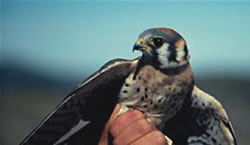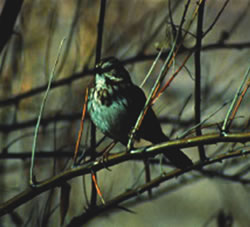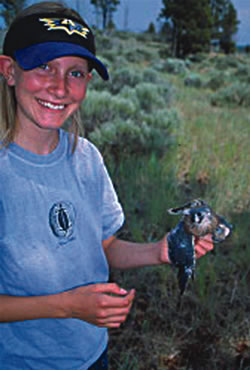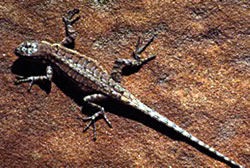The
smallest North American falcon, the American kestrel,
bears the cross of mistaken identity. The scientific
name Falco sparverius is, at least, somewhat correct.
Falco is a Latin word meaning “hooked” or “falcate” which
describes the shape of the claws. Sharp and shaped
like a scythe, the claws are used for grasping prey.
Sparverius is derived from the Old French espervier
meaning “falcon of the sparrows.” Older
field guides boldly pronounce this species as the “sparrow
hawk.” This is where the confusion arises because
the kestrel is not a hawk and small birds comprise
only a small percentage of their diet.
Though American kestrels do take small birds, like
sparrows, their diet consists more of insects, small
mammals and reptiles. I guess “insect hawk” or “reptile
hawk” just didn’t sound right. Plus the
kestrels other relatives — the merlin, peregrine
and prairie falcon — are proficient hunters of
birds. Perhaps the early naturalists assumed that the
kestrel would follow in the wingbeats of the other
members of the Falco genus.
Ornithologists borrowed the name “kestrel” from
the Eurasian kestrel, which our species resembles.
If you look up kestrel in Webster’s dictionary,
he defines it as echoic or an imitation of the Old
French word cresserelle.
Europe aside, kestrels are the most colorful birds
of prey in North America. Males and females wear different
plumages, although both have dark vertical sideburns
(often called mustache marks), reddish-brown backs
and pointed wings. The adult males differ in that their
wings are steel blue, the reddish tail has a large
dark band near the tip, and the breast is rufous with
dark spotting on the belly. The adult females who are
a bit larger than the males, sport dark barring on
their tail, brownish streaking on their breasts and
bellies, and have a small dark band near the tip of
their tail.
One feature both sexes share is a pair of dark spots
called ocelli on the back of their nape. These “false
eyes” are thought to be deterrents for predators.
The predators mistake the spots for watchful eyes and
try for some other prey. Probably a good feature to
have for a bird that spends a great deal of its time
looking down, but kestrels still fall prey to other
raptors.
Predators themselves, kestrels hunt mainly by the perch-and-pounce
method. They sit motionless on a fence post, tree limb,
telephone wire, or rocky outcrop and watch for movement
below. From their location they drop down on prey such
as grasshoppers, beetles, mice, voles, ground squirrels,
lizards, the occasional frog or toad, and snakes.
Another hunting behavior is by hovering over an open
field and then descending upon their prey. This type
of behavior is unique to the kestrels, so it is thought
to be more common than it really is.
Like their larger relatives the prairie or peregrine
falcon, kestrels are birds of open country. Don’t
expect to find them in deep woods; these are birds
along the woodland edge or in the open field. There
have been some noted declines in populations in the
northeast and Canada, but some researchers believe
that reforestation may play a role in limiting the
kestrel’s preferred habitat.
Kestrels occur in grasslands, shrub-dotted landscapes,
city parks, agricultural fields, rocky canyons, and
open woodlands. They need cavities in which to nest,
so they utilize abandoned woodpecker holes, crevices
or cracks in cliff walls or buildings, or nest boxes
to lay their eggs in.
Other than some small owls, like the screech owl or
boreal owl, kestrels are the only diurnal raptor to
use artificial nest cavities. You would think that
there are enough woodpecker holes or cracked buildings
to go around, but kestrels take to nest boxes like
ducks to a pond.
Most nest boxes are made of rough cut cedar, but any
untreated wood would work. The boxes generally are
8-10 inches tall and 7-8 inches wide. The entrance
hole is 2.5-3 inches wide and circular. A good placement
for a box is where the entrance hole is about 15-20
feet up from the ground, faces the southeast and is
generally unobstructed. Since kestrels don’t
add nesting material to the box, a 2-3 inch layer of
wood shavings with some wood pellets is added. Located
near some perches, the kestrels will take up residency.
Sometimes nest boxes are mounted on power poles or
highway signs. On your next trip to Grand Junction,
check the westbound signs along I-70 in Colorado for
these boxes. Though the highway traffic is a hazard
the kestrels must contend with, often the median strips
represent a smorgasbord of insects and small mammals.
Around Moab, kestrels are fairly common. In the fall,
migrants move southward from their northern breeding
grounds. Attentive birders may notice numerous birds
perched along telephone lines or hovering over the
edge of an agricultural field. If you’re able
to watch the hunting antics of these small falcons,
you might get a sense of some of their other names
like “house hawk, killy hawk or windhover.” Monikers
like those makes “falcons of the sparrows” seem
like an OK name after all.
|






|